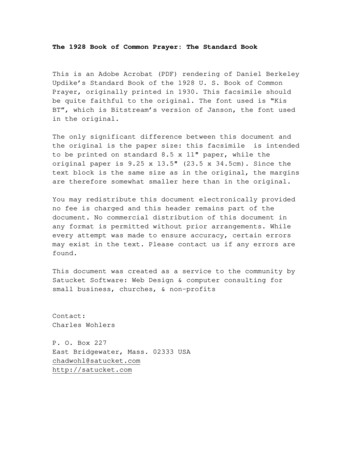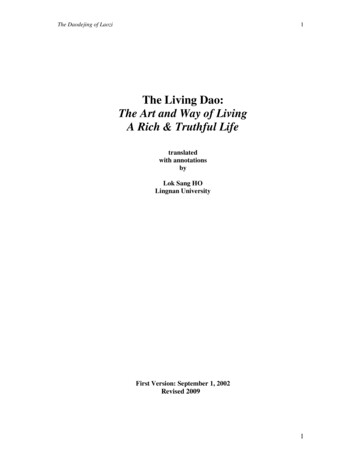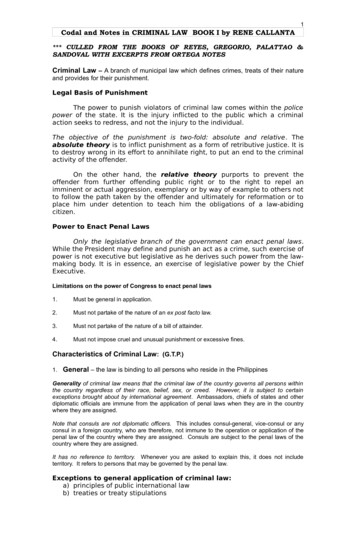
Transcription
Dr Shave’s Book of ShavingGet The Perfect ShaveThe expertguidetotheworldofshaving
Dr Shave’s Book of ShavingContents0305101323283235IntroductionChapter 1History of ShavingChapter 2Shaving CreamsChapter 3Shaving ToolsChapter 4How to ShaveChapter 5Head and Body ShavingChapter 6How to Groom Your Beard and MoustacheChapter 7Shaving Problems 2
Dr Shave’s Book of ShavingIntroductionDr Shave aka Brian MulreanySales Director & Co-Owner ofThe Executive Shaving Companygetting good wet shaving results. I willpersonally reply to every enquiry by‘phone or email.A lifetime wet shaver, previously usingGillette cartridge blades, I began using aMerkur safety razor, shaving brush andshaving creams and soaps for the firstaround 1993.In most cases simply moving from anelectric shaver or multi blade cartridge razorto a safety razor will solve problems suchas ingrown hairs, razor burn and excessivesensitivity. Sometimes it is poor shavingtechnique that’s causing the problem, eitherway Dr Shave has a solution.Since then I have test shaved more than100 different razors, Merkur, Feather,iKon, Above the Tie, Timor, Muhle and aselection of vintage safety razors too aswell as a few cut throats.I’m personally responsible for thesuccessful launch of the ExecutiveShaving own brand range of razors,brushes, balms, soaps and creams.Dr Shave loves to hear directly frommen who are yearning for the ‘perfectshave’ and from men who have problemsDr Shave knows that being clean shavenis only part way to being recognised asa ‘well-groomed gent’, other importantmatters to consider include dressingappropriately for the occasion, choosingthe right clothes for your age and personalhygiene is of paramount importance.Few things irritate Dr Shave more thanunsightly, protruding ear and nose hair,bushy, unkempt eyebrows and dirty orbitten fingernails. The worst crime is bodyodour, there is simply no excuse for that! 3 Dr Shave
Dr Shave’s Book of ShavingDr. Shave’s Book of Shaving welcomesyou into his world.This book will tell youeverything about the world of shaving andprovide the best ways of improving yourshaving experience.Then it’s time to put it all behind you. LetDr. Shave take you through his shavingprocess, explain the do’s and don’ts andhelp you to take proper care of your skin.Achieve the ultimate shave!For many, the introduction to shavinginvolved watching their father slap foamon his face, painfully scrape a safety razoracross it, and then go through the eyewatering ritual of applying aftershave. Keepthose treasured memories but let Dr Shavegive you some better shaving advice.Let me take you through:If you’ve ever: Tried various shaving fads like a 5blade vibrating razor with built in light,sideburns trimmer and Flexball glidetechnology only to be disappointed. Ripped your face to shreds using a cutthroat or safety razor. Found yourself disillusioned with thevast array of shaving products thatclaim to take you to the promised landof ultimate shaves. Been overwhelmed with the amount ofuseless shaving advice out there. History of Shaving – A fascinatingsubject but if you want to skip this andfind more pertinent needs I won’t holdit against you. You can always comeback to it when your partner has leftyou for not knowing about flint razorsfrom 30,000 BC.In this history lesson I’ll tell you aboutearly shaving tools, the reasons whybeing clean shaven has its advantagesin the battlefield and also how ithelped prevent nasty diseases andinfestations. Shaving Creams – I’ll tell you aboutthe various types of lubricants, creams,soaps, foams and gels and share myvaluable recommendations. 4 Shaving Tools – By this I meanrazors, brushes, strops and everythingelse associated with shaving. How to Shave – Step by step guidecontaining the best hints and tips forshaving using various types of razors. Head and Body Shaving – A morecommon practice these days, so youshould know how to do it properly. How to Groom Your Beard andMoustache – Look after your facialforest or neat ‘tache and style it theway you want. Shaving Problems – Serious stuff.Shaving sensitive skin, razor burn,ingrown hairs and razor bumps areall things that can be avoided withthe right technique, products, careand attention. Let Dr Shave take yourpain away.
Chapter 1History of Shaving 5
Chapter 1History of ShavingShaving can be traced back toprehistoric times when early manfirst started to pull hairs from hisface. In the following centuries varioustools were employed to scrape hair fromthe faces and bodies of both men andwomen. It wasn’t until the 19th century,with the industrial revolution, that the artof shaving became possible.Early DaysEvidence of shaving in prehistoric timescomes from cave paintings which showthat sea shells were used as tweezers topluck the facial hairs. Flint razors havebeen found from as early as 30,000 BC.It is thought that shaving was done formany reasons: hygiene to avoid food becoming caught up inthe beard minimise breeding grounds for lice andother parasites to avoid the beard being used as ahand hold in combat vanity since the beard was associatedwith old age and death.Early FashionsBefore AD 100, the Greeks and Romanscontinued to shave their faces andheads, probably as a hygienic measureto minimise infestations of lice andother parasites.Early Tools and CreamsArchaeological evidence shows that thenext step was due to the metallurgicaldevelopments of the Bronze Age. Copperrazors were discovered in India and Egyptdating back to 3,000 BC. Various othertools, creams and potions were usedover the next millennia and in 500 BCthe first barber shops began to appearin Rome, where the tonsors (barbers)used iron razors.Women had to resort to using lampsto singe off their leg hairs as well asrazors, creams, tweezers and evenpumice stones. 6 In the military, shaving the head and facehad the additional benefit of preventingthe enemy from using hair as a hand hold.
Chapter 1 History of ShavingAround AD 100, when the EmperorHadrian rose to power, it becamefashionable for men to wear beards.straight razor, allowing only a smallportion of the edge to protrude. Perretnever patented his invention.AD 476-1270 – during this time, the trendwas for ladies to painfully remove allhair from the body including eyebrows,eyelashes, temples and neck in order tolook chic.Early Safety Razor Improvementsand Shaving SoapsThe Twelfth Century saw radical changesto the way many societies dressed andgroomed. At the start of the centurynearly all French men, for example,wore full beards, but by 1400 most wereclean-shaven.In the mid to late 1700s - men andwomen began to remove all hair fromtheir foreheads in order to wear artificialpress-on mouse skin eyebrows.Early Literature andSafety Razor EvolutionIt is believed the honour of devisingthe first safety razor goes to JeanJacques Perret (1730-1784) of Paris,In Sheffield, England in the 18th and 19thcentury, they produced steel straightrazors. Their main drawback was thatthey became dull quickly, and so hadto be honed and stropped frequently tomaintain a sharp edge.France. Perret was a master cutlerand famed author of Pogonotomie, auL’Art D’Apprende à se Raser Sol-Méme(Pogonotomie, or The Art of ShavingOneself) in 1769 and L’Art du Coutelier(The Art of the Cutler) in 1771. Theoriginal Dr. Shave!Perret described a device he called a‘rasoir à rabot‘– a plane for the beard,which he had invented in 1762. It wasinspired by a carpenter’s plane, andconsisted of a wooden sleeve thatenclosed the blade of an ordinary folding 7 In 1847 a significant invention was madeby Englishman, William Henson. Hensoncreated the first ‘hoe type’ razor with theblade perpendicular to the handle, justlike a garden tool - similar to what we’refamiliar with today.This design made it easier to shaveoneself, reducing the need for a barberand became an overnight success.The earliest known soap recipe wasfound in the Egyptian Ebers Papyrus, amedical document from about 1500 BC,
Chapter 1 History of ShavingThe first patent for a safety razor wasfiled by the Kampfe brothers in the USin the 1880s. This featured a wire skinguard along one side of the razor’s edge.Only one side of the actual blade wasused and because it was made of forgedsteel it had to be removed frequently forsharpening.which describes combining animal andvegetable oils with alkaline salts to form asoap-like material.Soap making first became a commercialactivity in the 19th century after a Frenchchemist Michel Chevreul discoveredthe chemical nature of and relationshipbetween fats, glycerin and fatty acids.Further advances during the industrialrevolution saw soap transformed froman expensive luxury to an everydaynecessity by 1850.Shaving soaps and aftershave lotionsmade from cherry laurel water alsoappeared in the late 1800s.Despite this the Kampfe razor was thebest safety razor on the market at thetime and it would take the interventionof the most famous name in shaving tochange everythingTime for GilletteIn 1903, Mr King Camp Gillette, togetherwith William Nickerson launched a newconcept in shaving - the disposablerazor blade. Together with a modifiedform of safety razor designed to allowthe easy replacement of the worn blade,this new innovation revolutionised theshaving market.Gillette became an overnight successproducing 90,000 razors and progressing 8 to 2.5 million blades in the second yearof trading. Continual improvements haveensured that the company he foundedremains the leading supplier of shavinggoods in the world today.20th CenturyIn 1910 an American, Willis G Hockey,received a patent for the first mechanicalshaver. The ‘wind up safety razor’incorporated a pull cord to drive a flywheelthat operated for a short period of timebefore it needed to be wound up again.In 1915 the Wilkinson Sword Company,a manufacturer of razor blades for men,launched a campaign to encouragewomen to shave their armpits. This wasbased on the premise that it was bothunhygienic and unfeminine to keepunderarm hair.Another American in 1921, Lt. Col. JacobSchick invented a new razor called the‘magazine repeating razor’, which hadreplacement razor blades stored inside itshandle. Blades were purchased in clips,
Chapter 1 History of Shavingwhich were inserted easily into the razor.Schick also began to develop his ‘injectorrazor’, which would become an extremelypopular shaver in the years to come.The Philips Company, of Philishave fame,produced electric razors in the years1939 – 2006 under the Philishave brandand still produces them today under thename of Philips.In 1927 the same Colonel invented theWorld’s first electric dry shaver, withoscillating blades. This became availableto the public in 1929 but wasn’t met withmuch enthusiasm. He had to wait anothertwo years until an electric motor had beendeveloped that was small enough to fitinto a hand-held device, yet powerfulenough to cut through a beard.Modern DayGillette manufactured carbon steel bladesup until the 1960s but in 1965, the BritishWilkinson Sword Company introducedstainless steel blades that, with notendency to rust, could be used until blunt.Wilkinson Sword soon captured theBritish and European markets and Gillettewere forced to switch to stainless steelto compete.Modern carbon steel blades are stillavailable and should not rust if rinsed inalcohol after use - top tip!In 1931, he sold his first electric razorin New York for 25 and managed tosell another 3,000 that year. Schick’sgadget caught the public’s imaginationand by 1937, 1.5 million were in use. Itwas not long before other manufacturers,including Gillette and Remington, beganto produce their own electric razors.1974 - the first completely disposablerazor was introduced from Bic.Gillette’s response was the Good Newsdisposable razor which was launched onthe US market in 1976.Another important inventor was Prof.Alexandre Horowitz, from PhilipsLaboratories in Holland, who invented thevery successful revolving electric razor.Now there are numerous disposablerazors available, most of them designedwith the emphasis on economy and notshaving performance. 9
Chapter 2Shaving Creams 10
Chapter 2Shaving CreamsShaving cream is a lubricating creamthat is applied to the face and helps therazor to glide smoothly over the skin andis important in avoiding nicks, razor burnand irritation.There is a huge range of creams availableto the consumer making selecting theright cream a tough decision.However, you’re in safe hands with Dr.Shave. I’ll describe the products andstate the advantages and disadvantagesof each type. This way, you can make aninformed decision as to which product isbest for you. Trust me, I’m a Dr.Foam and GelTubs and Tubes Usually alcohol based Cheap, chemical based substitute for natural productsOften dries the skin excessivelyNot a ‘true’ wet shaveThey are full of air whichmeans you cannot possibly getthe lubrication needed for acomfortable, close wet shaveThey use synthetic perfumes forthe scent and not essential oils. 11 Almost always alcohol freeEasier on the skinSoftens the beard hairA true wet shave as the waterused to soften the beard remainson the faceOften contains essential oilswhich are kind to the skinVery easy to lather up into a rich,creamy consistency.Shaving Creams
Chapter 2 Shaving CreamsShaving CreamsHow to Use Shaving CreamIf you can’t get your hands on shavingcream, you could use regular facialsoap in an emergency but only inan emergency. Prior to your shave, lather up with ashaving brush dampened with warm(not hot) water and apply to the beard. If you don’t have a shaving brush,apply the cream sparingly with yourfingertips to the area to be shaved butfrankly a shaving brush is far sexier forlathering up. Shave as normal. Modern day shavingcreams rinse away almost instantly,without a trace of residue. Good quality moisturising shavingcreams are carefully formulated,economical to use and give anexcellent lather for a com
Dr Shave knows that being clean shaven is only part way to being recognised as a ‘well-groomed gent’, other important matters to consider include dressing appropriately for the occasion, choosing the right clothes for your age and personal hygiene is of paramount importance. Few things irritate Dr Shave more than unsightly, protruding ear and nose hair, bushy, unkempt eyebrows and dirty or .











